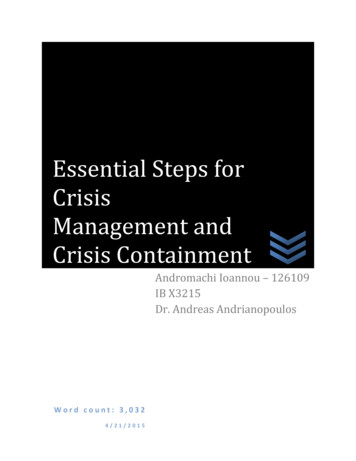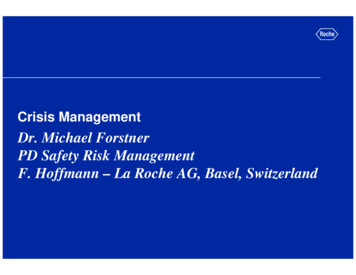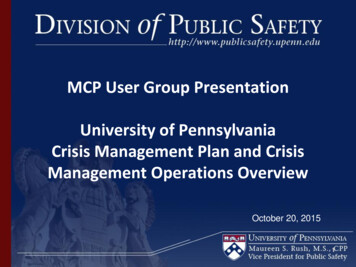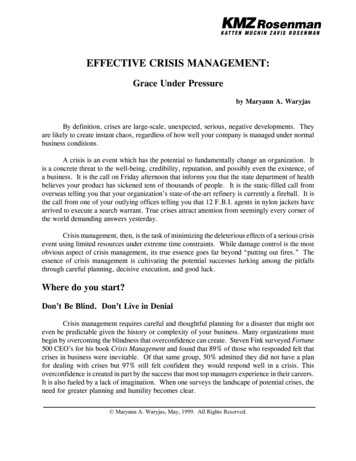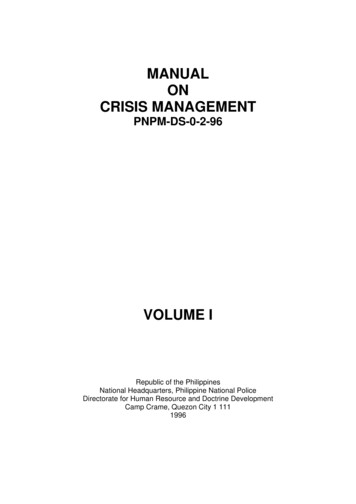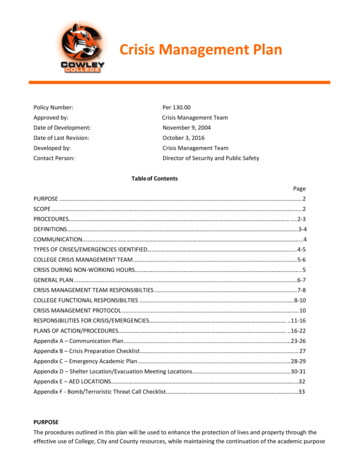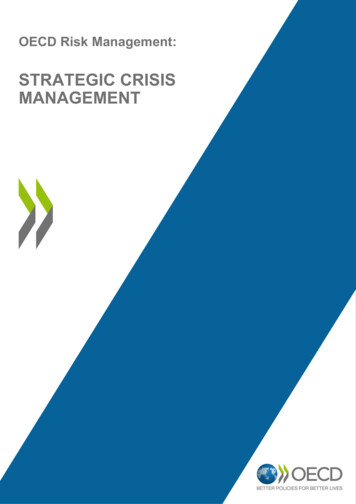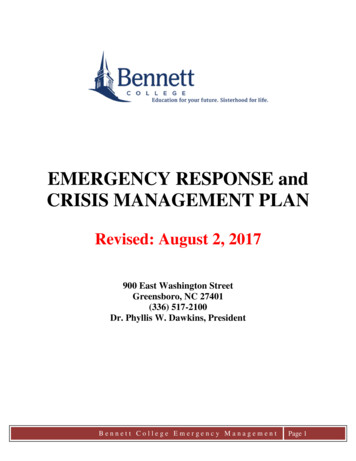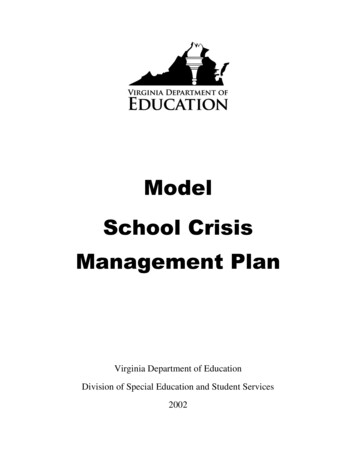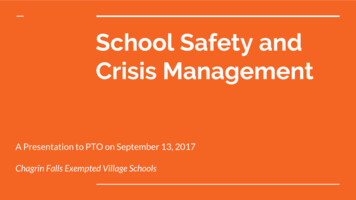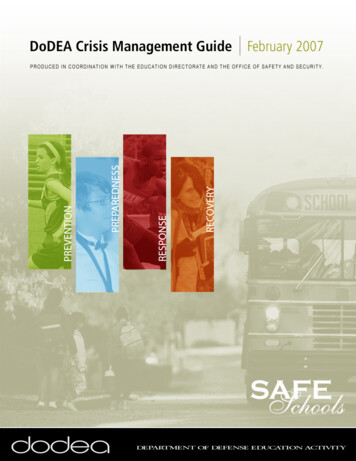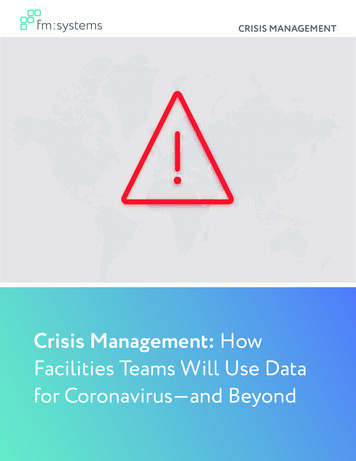
Transcription
CRISIS MANAGEMENTCrisis Management: HowFacilities Teams Will Use Datafor Coronavirus—and Beyond
IntroductionFacilities management teams serve on the front lines of the fight against global pandemics in thebusiness community. During the current COVID-19 coronavirus outbreak, facilities managers arehelping head up corporate response in terms of employee safety and health, and they’re fillingcrisis manager and response coordinator roles.One of the most valuable tools possessed by facility management leaders is highly accuratefacilities data including spatial information of both employees and assets associated with theday-to-day business operations. FM:Systems created this guide to help you think through employeehealth and business continuity issues, including how to use workplace management solutions tosupport your organization.
Coronavirus: What Businesses Need to KnowSARS-COV-2 is the name of the coronavirus and COVID-19 is the disease that this virus causes. Thispandemic is more urgent than other public health crises in recent history because of its global spread, highrate of transmission, long and often asymptomatic incubation period, and the high percentage of casesthat require serious hospital care.This coronavirus is predominantly spread through droplets expelled during coughs and sneezes and touchfomites on surfaces. Smaller, aerosolized particles may be able to linger in the air for several hours andthe virus lives on surfaces for up to several days. Soap and water as well as a variety of commercial andhousehold cleaning solutions (see Appendix) are effective ways to disinfect surfaces and hands.Source: NPRHow “Flatten the Curve” Affects Business OperationsAs the pandemic intensified, government response shifted from a strategy of containment to mitigation.The new goal to “flatten the curve” aims to prevent large numbers of severely ill people from needinghospital services at the same time. This should protect the healthcare system and buy time to developtherapeutic treatments and a vaccine. National, state and local governments have issued guidance fornonpharmaceutical interventions (NPIs) with significant business impacts: Travel restrictions (international and domestic)Telework mandates (work from home)Limitations on the size of public and private gatheringsSchool closures (employees will have children at home)Event cancellations (sports, entertainment, trade shows)Orders to close businesses where people congregate (bars, restaurants, salons, spas)“Shelter in Place” orders (also called full lockdowns over localities or states)
The Role of Facilities Management in Crisis ResponseWhen a pandemic or other crisis strikes, facilities management will be called up to help businesses ensurebuildings and employees remain safe and healthy. The data you collect every day through workplacemanagement technology can support the business during challenging times. Let’s examine some of theareas to include in crisis management plans and how workplace data may allow your company to respondmore quickly and effectively.Employee Health and SafetyCleaning and SanitationIf your business is not ordered to close by the government and you remain open through the pandemic,cleaning and sanitation will be the most important tool to help employees stay safe and healthy. Normalsanitation procedures and cleaning frequencies may not be sufficient—especially in areas such as restroomsand meeting rooms and high touch surfaces such as door handles, faucets or keypads. Your plan shouldinclude processes for decontaminating workspaces and common areas if confirmed cases present amongemployees or visitors to your buildings.Planning Questions: How often will individual workspaces require cleaning during the outbreak? What areas require more frequent cleaning, such as communal areas? When employees test positive for the virus, what additional deep cleaning and disinfection measureswill need to be performed and where? What cleaning solutions provide adequate disinfection for this virus? (see Appendix) What personal protective equipment (PPE) do janitorial and maintenance staff need to avoid becominginfected?How Workplace Management Technology HelpsPreventative maintenance solutions can help youmanage repetitive cleaning tasks by extending it toyour janitorial and sanitizing operations. Prescheduleadditional work orders for wiping down high touchsurfaces, including flat surfaces, door handles,elevator buttons, handrails, and touch screen panels.Real-time occupancy data and alerts enable you tomake rapid adjustments to your planned cleaningschedule. For example, you could send priority workorders for cleaning the work area of an employeewho has called in sick with the virus. Or you couldquickly send janitorial crews to meeting rooms wheregroups have gathered, after their meeting has ended.
Fixed Asset Management to Promote HygieneYou may need to quickly install some new fixed assets that support employee hygiene in better ways.You will definitely want to place hand sanitizer stations with signage near every entrance to the buildingand inside the building in strategic locations. Additionally, you might want to put up posters directingemployees to wash hands frequently, cough or sneeze into tissues, and stay home if ill.Planning Questions What is the correct number of hand sanitizing stations for the building? Where should we place the stations? Should we place educational posters for handwashing or other hygiene instructions? Could we benefit from retrofitting bathrooms with more touchless fixtures such as auto-flush toiletsand hand-sensing faucets and soap dispensers and touchless paper towel dispensers? Do our restrooms have doors with handles or knobs? If yes, should we provide paper towels so employeesdo not have to touch these surfaces and can exit the room with clean hands?How Workplace Management Technology HelpsAsset tracking technology keeps track of the location of equipment and supply areas and when coupledwith preventive maintenance programs can enable facilities management to direct tasks such as locating,inspecting and filling hand sanitizers, and restocking cleaning materials.
Physical Space Management for Social DistancingGovernments have been issuing guidance to employers about how to increase the social distance betweenemployees. Telework is strongly preferred, when possible. For those who cannot work from home, businesseswill need to help maintain six feet distance between employees as they work.Planning Questions How many employees have jobs that can translate to a remote work situation? What is needed for IT to quickly ramp up network access and equipment for home workers? For workers who remain in the building, how many could be moved to private offices? What is the density of workspaces in each area of the building? How can we assign employees to workspaces that are at least six feet apart? What is the capacity of common areas such as break rooms, meeting rooms or cafeterias? How manyemployees should be allowed there during social distancing? Could workers be separated into multiple shifts, with enhanced cleanings between shifts, in order toexpand space between workstations?How Workplace Management Technology HelpsRemote Work: After the pandemic has passed, not all employees may return to full-time office work. Remotework is the new reality; some employees find themselves more productive without office distractions. Ifmore people work from home, companies can achieve higher real estate utilization with a hot deskingstrategy, also called hoteling. You may not want employees to share desks, phones, and keyboards untilafter the pandemic. But when you’re ready to pursue hot desking, your workspace management solutionwill provide the reservation system.Workspaces: When you’re planning for social distancing of employees, your workplace managementsolution provides a physical space inventory for studying your organization’s building and determining thetypes of spaces and their associated risk. Physical space inventory data identifies areas where employeescongregate that may be more susceptible to the spread of COVID-19.
Meeting Rooms: During social distancing, you will want to keep group meetings small. In addition toleaving six feet between workers, you need to comply with government mandates about limited gatheringsizes. Your physical space inventory will identify the normal capacity of meeting rooms on the visualfloorplan. Use your meeting room reservation system to adjust room capacities down during the pandemicto maintain social distancing. Track the usage of any reserved space over time by reviewing bookinghistory. If your organization has deployed occupancy sensors, mobile booking apps, or booking kiosks, it’seven possible to see if people actually showed up for a meeting.
Outside VisitorsDuring this pandemic, some buildings will opt to suspend outside visitors. The facility management teamshould guide the discussion about temporary visitor policies. If you are not using RFID visitor badges ortracking mobile device locations, it can be difficult to be certain about where visitors go after they gainentrance to the building.Planning Questions Do we have the ability to track the movements of visitors within our buildings? Can we enable telephone or video conferencing as a substitute for in-person meetings? How will we know if visitors have become positive cases for COVID-19?How Workplace Management Technology HelpsPeople leave an amazing amount of digital fingerprints across every space they occupy. If your companylacks the ability to track visitors’ locations, you could use data about the employee’s visitors are meetingas a rough proxy for visitors’ locations.Air Quality Inside FacilitiesBecause the SAR-COV-2 virus travels in respiratory droplets and aerosols, you will need to considerprocedures to maintain and decontaminate the heating, ventilation, air-conditioning systems in buildings.You might also need to increase air flow and bring more fresh outside air into the building.How Workplace Management Technology HelpsEnvironmental sensors can map air quality on a visual building floorplan, allowing you to see areas that mayneed better air flow. Preventative maintenance systems enable you to schedule new HVAC decontaminationroutines and schedule more frequent filter changes and other maintenance tasks.
Business ContinuityFacilities management has an important role to play in keeping leaders apprised of situations that couldnegatively impact continuing operations. Real-time workplace data is of paramount importance. Here arefour ways to use workplace and facilities data to support business continuity:1. Monitoring Absenteeism: Help executives predict surges of absenteeism: Occupancy sensors andvisual floorplans let you see when certain teams or physical locations of the building (departments, floors)experience higher rates of absence. This data—complemented by Time & Attendance data from HR—helpsleaders see how the pandemic is moving within the workforce.2. Tracking and Contract Tracing COVID-19 Cases: As cases arise, it will be critical for facilitiesmanagement to know where they’ve gone in the building. Employers and public health authorities willneed to know who else had contact with the individual over the prior 14 days. Occupancy sensors, networklogins, meeting room reservations, meeting requests, and badge swipes or door access information canenable you to track flow and map locations.3. Ensuring Employees Under Quarantine Orders Stay Out: Many people who test positive for COVID-19will experience only mild illness. They may feel capable of continuing to work, but they must not enter thebuilding—even after hours to pick up work for home. Use workplace technology to temporarily disable theindividual’s access for access for the proscribed time.4. Maintaining Supply Chains: Keeping employees healthy and the workplace sanitary are top facilitiesmanagement priorities. Data about past purchasing patterns of janitorial and hygiene products will helpyou project upwards for items that will be heavily consumed in the pandemic, such as hand sanitizer, paperproducts, and cleaning supplies.
ConclusionThis is a challenging time for businesses and the people that work for them. Facilities Management teamswill be on the front lines of helping their businesses adapt and evolve in a world of coronavirus, socialdistancing, and shutdowns. The organizations best prepared for crisis management are those with accessto highly actionable and accurate data about their facilities and employees and visibility to continuallymonitor their facilities portfolio and operations.Facilities managers who know how to leverage data streams flowing through their workplace managementtechnology and other operations systems will be well-positioned to weather the current pandemic. Theywill also evolve their readiness to face future situations because they have effective response plans andtechnology in place.Contact FM:Systemswww.fmsystems.comU.S. Toll Free:(800) 648-8030E-mail: info@fmsystems.comInternational:(919) 790-5320
Appendix Coronavirus (COVID-19) Resources for Facilities ManagersPandemic Planning Resources for Facilities ManagementIFMA Foundation Pandemic Preparedness ManualIFMA COVID-19 Preparedness Resource CenterCDC Interim Guidance for Businesses and EmployersASHRAE HVAC Guidance for COVID-19U.S. EPA List of Disinfectants for Use Against SARS-COV-2Global and Federal Information, Situation Updates, and GuidanceWorld Health Organization (WHO)UK COVID-19 Resource PageCenters for Disease Control (CDC)ScotlandUnited States GovernmentWalesJohns Hopkins University & Medicine Coronavirus Resource Center Northern IrelandU.S. State and Locality Guidance and OrdersAlabamaAlaskaArizonaArkansasCalifornia- Los Angeles- San FranciscoColoradoConnecticutDelawareDistrict of ColumbiaFloridaGeorgiaHawaiiIdahoIllinois
CRISIS MANAGEMENT Crisis Management: How Facilities Teams Will Use Data for Coronavirus—and Beyond. Facilities management teams serve on the front lines of the fight against global pandemics in the business community. During the current COVID-19 coronavirus outbreak, facilities managers are helping head up corporate response in terms of employee safety and health, and they’re filling .
